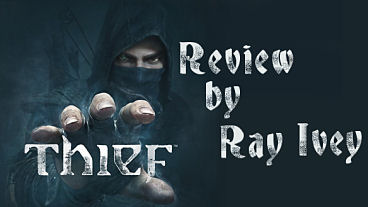
Thief – Review
Thief review by Ray Ivey. "If you were a fan of the first two games, I recommend you give Thief a look. Concentrate on the good stuff, hold your nose for the bad stuff, and you’ll have a good, sneaky time."

You can’t blame Eidos Montreal for trying. What ambitious studio wouldn’t be interested in creating a reboot of the fabled PC gaming franchise Thief?
The resulting game, after a painfully long development period is, at best, a mixed blessing. (Sigh.)
Before we continue, I’d like to just do a quick recap on why the original two Thief games are so important.
I. Why the first games are revolutionary
In the late 1990s, First-Person Shooters were really starting to rule the world. 1998, the year Thief: The Dark Project came out, also saw the releases of Half-Life, Unreal and Rainbow Six.
Along comes Looking Glass Studio’s Thief and its revolutionary, genre-creating gimmick: Turning the concept of a First-Person Shooter on its head. Thief uses a first-person shooter engine, format, presentation and mechanics in a fundamentally new way, thereby creating a totally new game experience.
FPS games are built on giving the game a visceral experience of feeling like a badass running through the game world shooting stuff. It’s all about aggression, mayhem and power.
Thief uses all of the mechanics of those games but gives you a confounding directive: Avoid confrontation and conflict. Slip into the shadows! Navigate the environments with a silky stealthiness that makes you invisible to the bad guys! The First-Person Sneaker was born.
Many gamers dislike stealth games. They consider them too slow and deliberate. Playing the first Thief, I realized I was the opposite: I LOVED the stealth mechanics!
One more point worth mentioning regarding the original games. The big fault with Thief: The Dark Project was that the developers didn’t quite have faith in their own vision, so that by the third act of the game, the gameplay had degenerated into a lot of monster combat. The designers listened to their audience, and the sequel, Thief: The Metal Age was a much more consistent game with more of what was good and much less of what wasn’t. This is how sequels should be built.
Okay, back to the present game.
For those of you new to the Thief series, you play master klepto Garrett, who lives in a vast, unnamed, vaguely Steampunk City that’s being torn apart by political and supernatural threats.
Let’s start with some of the good news first.
II. It’s gorgeous
Like any decent current-gen game, the environments in Thief are vivid and detailed. They’re not particularly colorful (hello, Dishonored), but considering you’re mostly skulking around in shadows, that’s perhaps forgivable.
III. Gameplay options Galore!
One of the very strongest aspects of Thief is its high level of gameplay customization. You get many meaningful choices about how you want to play the game.
There are three preset options:
Rogue, or “Easy,” gives you weak opponents with low awareness levels, along with cheap and plentiful resources;
Thief, or “Normal,” which gives you competent and aware enemies and affordable and available resources;
Master, or “Hard,” which gives you deadly opponents, a much faster-depleting Focus meter, more expensive resources and upgrades, and (this is key) civilian kills or even knockouts are absolutely forbidden.
These are three good choices right off the bat. But the game goes much further than that with the Custom setting options. You can disable all within-mission saves, turn off the Focus ability, make knockouts harder, turn off the aiming reticule, and several more important choices.
There’s an entire other set of display options that affect gameplay, allowing you to turn navigation prompts, alert markers (how aware the guards are of your presence), interaction prompts, mini-map, and other interface items on or off.
In other words, the player can fine-tune the game experience he or she wants. This is a fantastic system that I wish more games had.
Only complaint: NONE of the gameplay settings is changeable within the game. If you want to change the settings, you have to start the game over.
The result of these options is that you get to design the play experience you want. It’s to the designers’ great credit that the game is robust and flexible enough that this is possible.
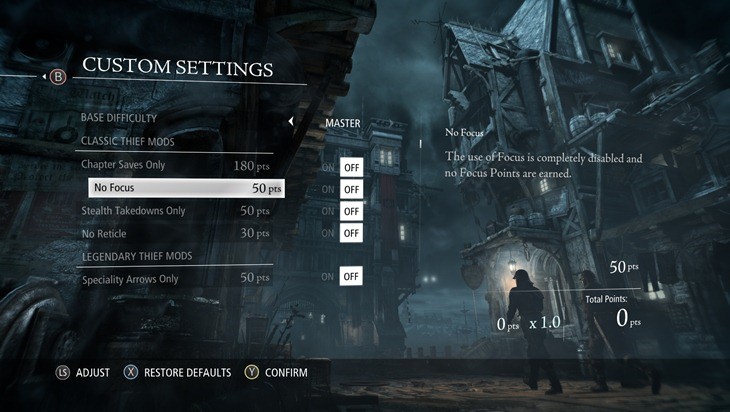
Want to be lethal? Snipe the guards from the shadows, raining death upon them and slithering away unharmed.
Want to be stealthy and believe that a thief isn’t a murderer? You can play it as I did, where you knock guards out but don’t kill them.
Want to be a true purist and “ghost” each mission, meaning you can’t knock out anyone and have to find a way to sneak past the guards? Go for it.
I frankly don’t understand why someone would play a game like Thief if they were interested in killing everyone. There are a million games where you get to kill everything that moves. But stealth is a relatively rare game component these days, and to find a game that’s primarily stealth is a treasure. Why waste it?1
IV. Solid Thiefy gameplay
Within the missions themselves, there’s a ton of fun to be had. If you like Thief games, or if you like stealth gameplay in general, you’re going to have fun slinking through the shadows, sneaking up behind (or past) unsuspecting guards, lifting tons of loot, finding secret passageways, unlocking doors and chests, and navigating a complex and dangerous environment.
The lock-picking is okay, but it’s pretty flat and doesn’t evolve at all, which is a shame.
Being able to peek through keyholes is a very nice, and sometimes even useful, touch.
V. Garrett’s voice and appearance (well, one out of two isn’t… that bad)
I don’t have a lot to say about Garrett’s voice. Much has been made about Stephen Russell‘s performance as Garrett in the first three games. I always enjoyed him, but his performance was never a game-maker or –breaker for me. So I was not upset that, this time around, Russell was not hired to perform Garrett. Why? Well, Russell’s voice had changed too much (the first game was sixteen years ago, after all). Also, the new game required performance capture as well as vocal performance. So the developers went with Canadian actor Romano Orzari to play Garrett.
All fine and good. Vocally, Orzari does just fine. But why does the new Garrett have to LOOK so terrible?
Here’s how our stealthy hero appears in the first two games:
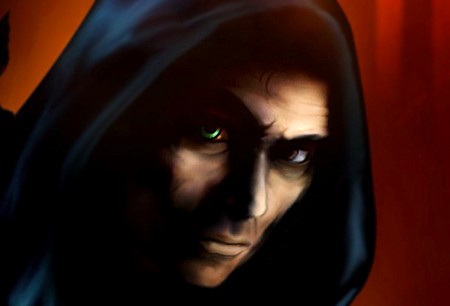
Okay, to be fair, that’s cover art. But it’s a decent representation of the way Garrett looks in Thief: The Dark Project and Thief II: The Metal Age.
He doesn’t look too bad in 2004’s reboot Thief: Deadly Shadows:
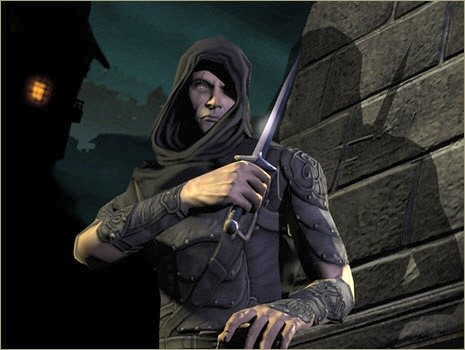
But this time around, sheesh. He’s pale, he’s ugly, and he’s wearing women’s lingerie. On the outside:
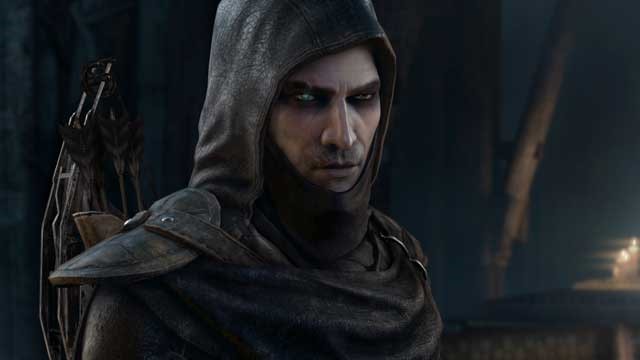
Trust me when I tell you that this snap makes him look better than he really does in the game.
Plus… he’s wearing a corset:
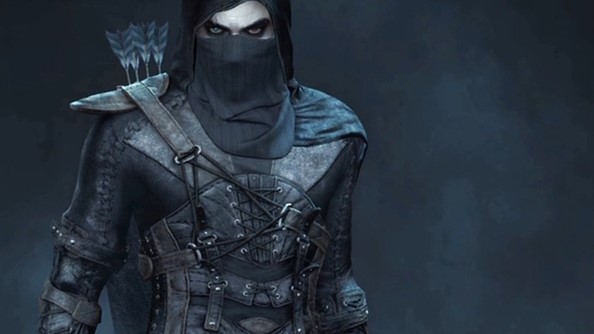
Yeah. It’s a corset.
Now, perhaps these issues strike you as idiotic to complain about, but I defend my crankiness on this point. In the first three games, Garrett was a sexy cat, slinking through the shadowy City and looking good while he did it.
And let’s compare him to three other stealth heroes of recent games, shall we? First there’s Corvo from Dishonored:
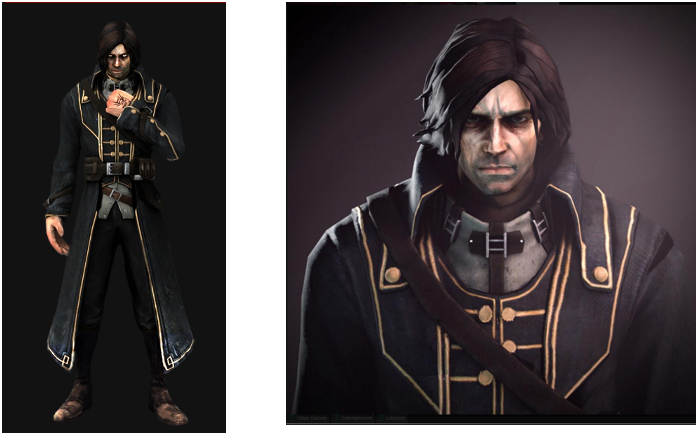
I know, right?
Then there’s Adam Jensen from Deus Ex: Human Revolution, a cyber-hunk if there ever was one:
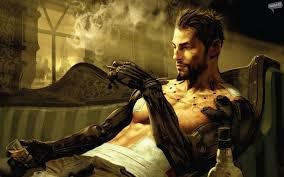
And of course there’s the pinnacle, the paragon of sexy stealth, Ezio Auditore from The Assassin’s Creed series:
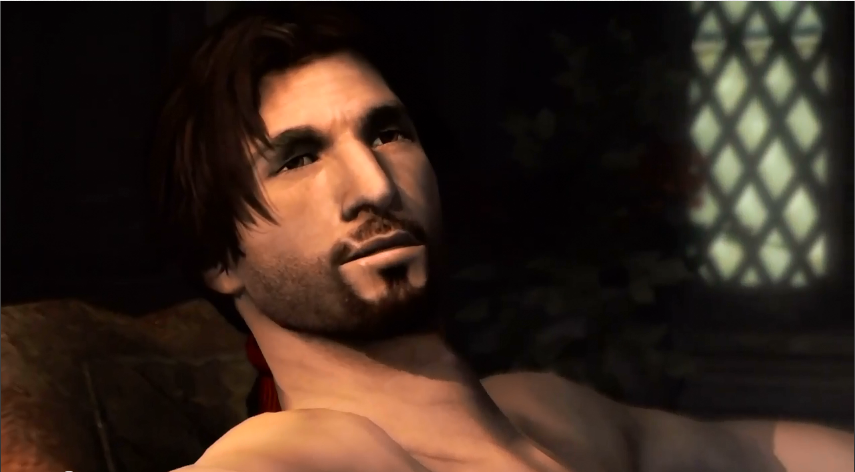
Come on. You’d let him assassinate you, right?
Hell, they could have made Garrett look more like the actor playing him. Even that would be an improvement over the Cadaver in a Corset they used in the game.
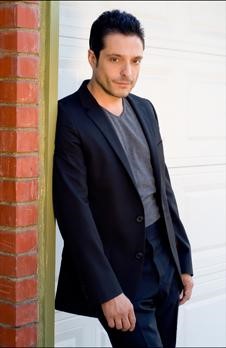
So by now you’re probably rolling your eyes and thinking I’m being crass and superficial, but honestly, games are entertainment. There’s no reason Garrett shouldn’t be appealing to look at as well as appealing to listen to. (Also: I am crass and superficial, so there’s that.)
VI. Focus: A mixed blessing
In Thief, the Focus ability operates a bit like mana. It serves two major purposes. One is terrific. The other, not so much.
The first purpose it serves is to highlight interactable items or areas in the environment. While this may strike the reader as a classic modern game “dumbing down” sin, I actually think it’s rather organic. Garrett is a master thief, after all. It doesn’t hurt my immersion one bit to consider that he can look at a dark room and quickly analyze what’s important more than an average person does.
What’s highlighted? Loot, throwable objects, climbing opportunities, torches and candles, traps, rope arrow opportunities, alarm birds, alarm dogs, guards, and some civilians.
(Of course, if you’re too badass to use such a wimpy tool, you can turn it off in the Game Options.)
I use the Focus ability constantly when I play. It doesn’t feel like cheating. It feels like being a professional.
The second purpose of Focus is the mana-like property that lets you perform special feats, like slowing down time, moving more quietly, picking a lock more easily, etc. The problem with this second category of Focus functionality is the fact that when you use it in this way, your limited supply of Focus drains very quickly. And it does not regenerate, even slowly. The only way to regenerate it is to purchase VERY expensive refills (at least on Master difficulty) or find (rare) flowers that replenish the resource in the game world.
This basically means the Mana-like Focus abilities simply are too expensive to use, except in emergencies. And the only problem with that is since you only use these special abilities in emergencies, you haven’t had the opportunity to practice them. Which means you suck at those moves or abilities and using them is awkward and stressful.
I barely use this second functionality of Focus. It just isn’t worth it.
VII. Sound
The original Thief games have such great sound design that you play the games as much with your ears as you do with your eyes. As you huddle in the shadows, you listen breathlessly for a guard’s footsteps to get closer or farther away. Where a guard’s voice comes from matters. In this current game, you can barely ever hear guards’ footsteps at all, and the sound design is way off: You’ll overhear conversations that seem to be right behind you, even though they are floors, rooms, or even blocks away. This is a missed opportunity.
(And yes, there’s a special Focus upgrade that sort of addresses this issue, but as mentioned above, using Focus that way sucks.)
VIII. Problems with the game save mechanic
Like many console action games, Thief has automatic save points. In general, I don’t mind this. Sure, I’d rather be able to save anywhere I damn well please, PC-style. But I play lots of console games so I’ve made my peace with the save-point system.
The game even provides handy cabinets scattered around the levels that allow you to hide and make between-auto-save-point saves. Once I figured out that these were not just for hiding, but for saving, I began using them a LOT.
But there’s still a problem with game-saving.
I call it the Point of No Return problem.
At various points in each level, as you progress, you trigger locations from which you cannot return: drops that you can’t climb back out of, doors and gates that only open one way, etc. This is a problem because it’s too easy to trigger these cut-off points without realizing it. You may have other rooms or safes or whatever to explore back on the other side of these cut-off points. The game has many collectible items, after all. Or there may be something on the other side of the cut-off that has to do with an optional goal for that mission. Too bad! Once you’ve made this mistake, the only way to undo it is to finish this mission and then replay the entire mission again.
Let me say that again: If you realize you have buyer’s remorse about triggering a Point of No Return, your only option is to FINISH THE LEVEL and then REPLAY THE LEVEL AGAIN IN ITS ENTIRETY. This is simply unacceptable.
There’s no “Reload from last save point” option in the menu, and even if there was, that wouldn’t work, because accompanying each and every Point of No Return is, you guessed it, an automatic save!
The game should let you re-start at ANY save point in the mission. Barring that, there should, at the very least, be a “Restart Mission” option. But nope, nope, nope. It didn’t seem to occur to anyone at Eidos Montreal that this saving model would upset anyone.
Considering all the admirable play-style options Thief has, it’s a shame this mechanic undercuts the player’s investment in each mission in this way. If I’ve just spent four hours on the first part of a mission, determined to get the “Collect All Loot Items” bonus, and then you pull the rug out from under me like that, I suddenly care a lot less about finishing the mission with any personal style or goals. I just want to finish it.
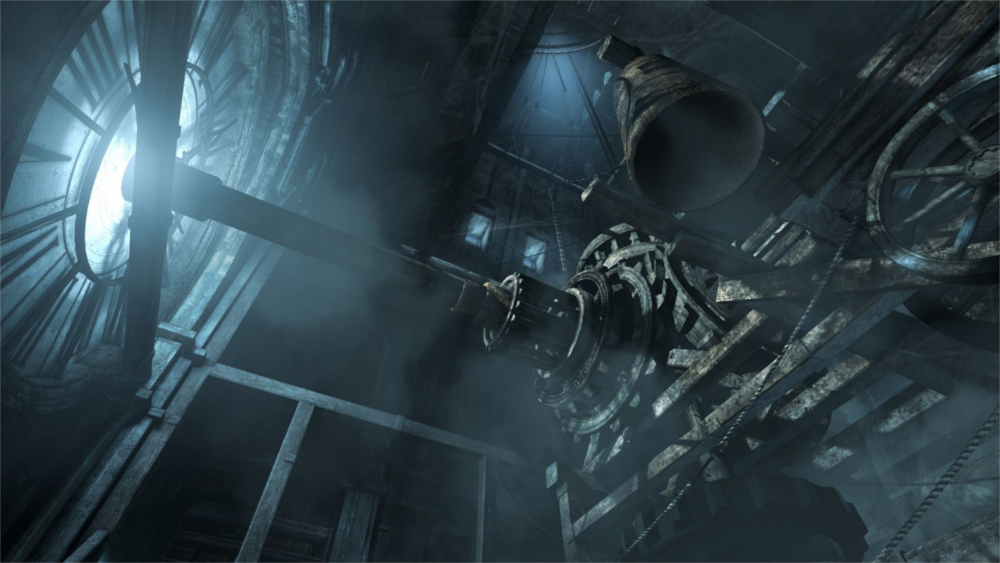
Eidos Montreal: It’s a good idea to TALK TO GAMERS when you are making dumb decisions like this. Let us help you.
IX. Problems with NPC dialog
In any game like this, you’re going to hear the some of the same lines over and over. I call it the “Arrow in the Knee” problem. This is going to be particularly true in any game that has you lurking around scores of anonymous guards. Hearing the guards talk to themselves and each other is one of the main ways the game alerts you that unseen guards are near. In most games you learn to roll your eyes a bit when you’ve heard the same comment for the 89th time. It’s particularly annoying in Thief, because it feels like there are only about seven phrases all of the guards say over and over:
“You can smell the river from here.”
“What happened to this place?”
“What’s next?”
“What happened to the sloop sellers?”
And not many more. After awhile it really begins to pull you out of the experience. (Besides, dude, seriously: Can you really smell the river from EVERYwhere?)
The first two Thief games solve this problem in an ingenious way. Religion plays a large part in the lore of those games, and as a player you become familiar with the characteristics of the various faiths. Many of the verbalizations of the guards you encounter are simply muttered prayers. Hearing the same prayer over and over again doesn’t seem weird at all.
This is another bit of elegance the old games feature but the new game lacks.
X. Dumbed-down level design?
Much has been made by other game journalists about how deliberately the levels are designed. In the original games, if you had rope arrows, you could shoot them into any wooden beam you could find, and see where it would lead you. In the current game, the only places you can shoot such an arrow are specifically designed hotspots (revealed, if you choose to use it, with the Focus ability).
While it’s true that these “hat pegs” make the strategic options feel a bit literal, I didn’t mind them as much as I expected to. In general, the main mission levels are huge, and I used these hotspots as shorthand to signal me that here was a potential place to find a secret, or a new route. I enjoyed them. Purists might disagree with me.
XI. A dishonorable comparison
One of the biggest problems Thief faces is that a much better Thief Game came out in 2012. It was called Dishonored. Of course it wasn’t really a Thief game but it might as well have been, and it pretty much outshines the current game in every relevant way.
Dishonored’s Dunwall is vibrant, colorful, weird, and fascinating, with a coherent history and an understandable crisis. Thief’s city, while attractive, feels generic by comparison, and the story is just hash, just boilerplate.
XII. The City, The City, The City
I love that Thief takes place in a huge, mysterious city. And I admire the designer’s desire to have it serve as the overworld hub between all of the missions. However, after the first few hours, the City just becomes one big irritation.
Since the various portions of the City are designed to be a labyrinthine maze full of hostile guards, moving through it feels like an extra mission. There are even tons of fun loot and other secrets to find within its narrow confines. However, once you’ve fully explored each area of the City, you feel as though that mission is complete.
Alas, it’s not. Every time you need to cross the City to get to a new objective, you have to navigate the same ladders, alleys, tunnels, and guards. That’s not fun after fifteenth time. There’s no fast travel option whatsoever. Why did they think that would be fun?
Even worse, the City itself, and many of the missions as well, are divided into bite-sized pieces, divided by looooong (at least on the PS4) load screens. This really hurts the sense of immersion and simply becomes irritating.
XIII. And then there’s the crashing
Thief on the PS4 crashed more than any console game I’ve ever played. Whenever there was a loading screen, I’d say there was about a 15% chance the game would crash. Since there are MANY MANY loading screens in the game, this was a HUGE problem. And it’s a problem for which there is simply no excuse.
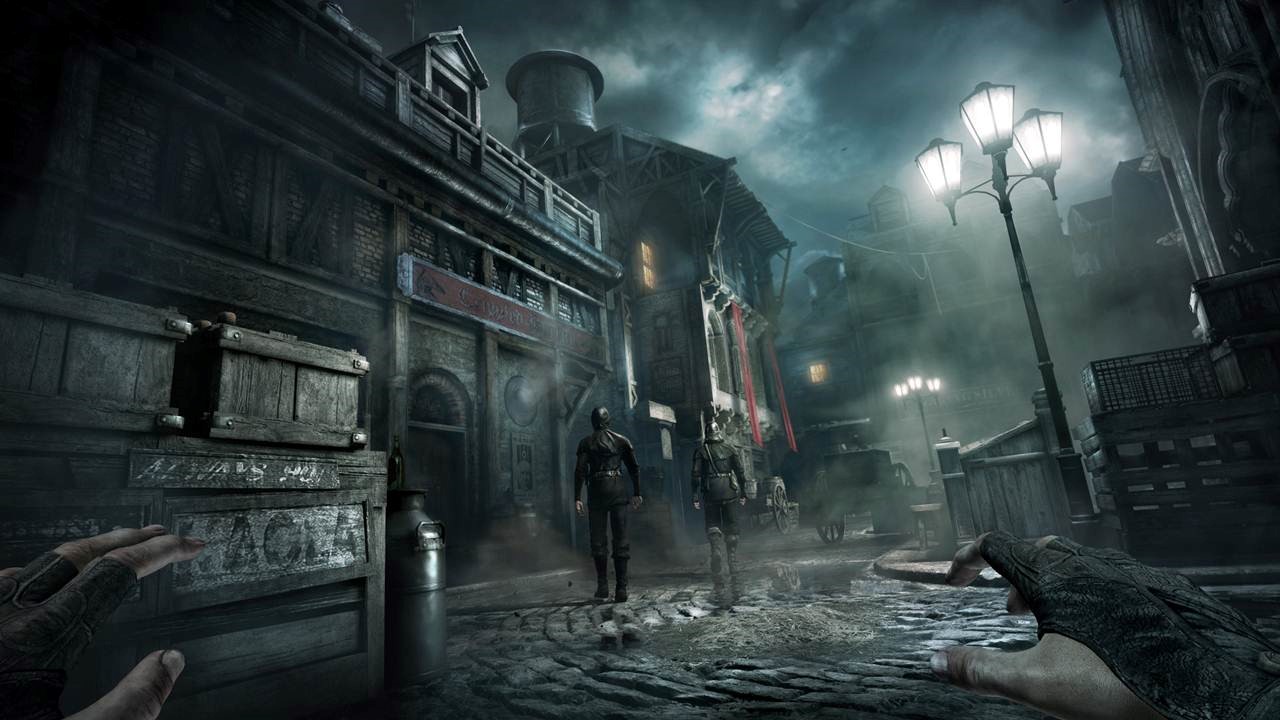
Oh, and did I mention that, due to the automatic saving feature of the game, you’ll frequently lose valuable gameplay progress with these crashes? Yeah.
XIV. Conclusion
Despite all of these complaints, I enjoyed Thief. I completed every mission, not to mention an extra DLC mission, and found a good percentage of the collectibles. The core gameplay is so strong and satisfying to a first-person stealth fan such as myself that even all of the missteps made by the designers aren’t enough to kill the experience.
It’s a shame it’s not a better game, though, because it didn’t sell very well. If it had, the follow-up game might have had some of these issues corrected, and the Thief franchise could be back on track! Alas, I have no hopes of another game in the series any time soon.
So: If you’re a fan of the first two games, I recommend you give Thief a look. Concentrate on the good stuff, hold your nose for the bad stuff, and you’ll have a good, sneaky time.
1 I played Bethesda/Arkane Studios’ Dishonored without killing a single thing, including my assassination targets! It was awesome.
|
Final Grade: B-
+ Reasonably atmospheric
+ Very strong core stealth gameplay
+ Lots of main missions and optional missions let you truly indulge your inner thief
+ Nice visuals
– Ugly main character
– Bad save system
– Flawed Focus system
– Weak sound
– Weak lore
– Terribly awkward overworld |
 |
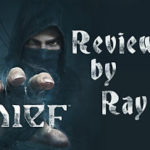
Leave a Reply